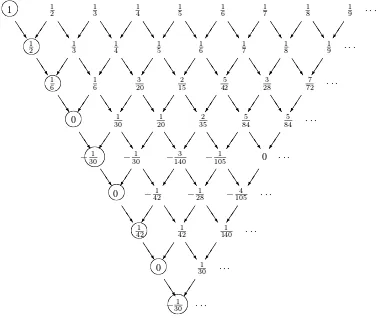23 11
Article 00.2.9
Journal of Integer Sequences, Vol. 3 (2000),
23 6 1 47
The Akiyama-Tanigawa algorithm for
Bernoulli numbers
Masanobu Kaneko
Graduate School of Mathematics Kyushu University Fukuoka 812-8581, Japan
Email address: [email protected]
Abstract
A direct proof is given for Akiyama and Tanigawa’s algorithm for computing Bernoulli numbers. The proof uses a closed formula for Bernoulli numbers expressed in terms of Stirling numbers. The outcome of the same algorithm with different initial values is also briefly discussed.
1
The Algorithm
In their study of values at non-positive integer arguments of multiple zeta
func-tions, S. Akiyama and Y. Tanigawa [1] found as a special case an amusing
algorithm for computing Bernoulli numbers in a manner similar to “Pascal’s triangle” for binomial coefficients.
Their algorithm reads as follows: Start with the 0-th row 1, 1
2, 1 3,
1 4,
1 5, . . .
and define the first row by 1·(1−1
2), 2·( 1 2−
1 3),3·(
1 3−
1
4), . . . which produces
the sequence 1
2, 1 3,
1
4, . . . .Then define the next row by 1·( 1 2−
1 3),2·(
1 3−
1 4),3·
(1
4− 1
5), . . . ,thus giving 1 6,
1 6,
3
20, . . . as the second row. In general, denoting the
m-th (m = 0,1,2, . . .) number in then-th (n= 0,1,2, . . .) row byan,m, the
m-th number in the (n+ 1)-st rowan+1,mis determined recursively by
Then the claim is that the 0-th componentan,0of each row (the “leading
diag-onal”) is just then-th Bernoulli numbersBn, where
∞
Note that we are using the definition of the Bernoulli numbers in whichB1=12.
This is the definition used by Bernoulli (and independently Seki, published one year prior to Bernoulli). Incidentally, this is more appropriate for the Euler
formulaζ(1−k) =−Bk/k (k= 1,2,3, . . .) for the values of the Riemann zeta
2
Proof
The proof is based on the following identity for Bernoulli numbers, a variant
of which goes as far back as Kronecker (see [4]). Here we denote by n
m the
Stirling number of the second kind:
xn= n
X
m=0
n
m
xm,
wherexm=x(x−1)· · ·(x−m+ 1) form≥1 and x0 = 1. (We use Knuth’s
notation [7]. For the Stirling number identities that we shall need, the reader is
referred for example to [5].)
Theorem 1
Bn= n
X
m=0
(−1)mm!n+1
m+1
m+ 1 , ∀n≥0.
We shall give later a proof of this identity for the sake of completeness. Once we have this, the next proposition ensures the validity of our algorithm.
Proposition 2 Given an initial sequence a0,m (m = 0,1,2, . . .), define the
sequencesan,m (n≥1)recursively by
an,m= (m+ 1)·(an−1,m−an−1,m+1) (n≥1, m≥0). (1)
Then
an,0=
n
X
m=0
(−1)mm!
n+ 1
m+ 1
a0,m. (2)
Proof. Put
gn(t) =
∞
X
m=0
an,mtm.
By the recursion (1) we have forn≥1
gn(t) =
∞
X
m=0
(m+ 1)(an−1,m−an−1,m+1)tm
= d
dt(
∞
X
m=0
an−1,mt
m+1)− d
dt(
∞
X
m=0
an−1,m+1t
m+1)
= d
dt(tgn−1(t))−
d
dt(gn−1(t)−an−1,0)
= gn−1(t) + (t−1)
d
dt(gn−1(t))
= d
Hence, by putting (t−1)gn(t) =hn(t) we obtain
hn(t) = (t−1)
d
dt(hn−1(t)) (n≥1),
and thus
hn(t) =
(We have used the recursionn+1
m+1 = (m+ 1)
Proof of Theorem 1. We show the generating series of the right hand side
coincide with that ofBn. To do this, we use the identity
ex(ex−1)m
which results from the well-known generating series for the Stirling numbers (cf.
by replacingmwithm+ 1 and differentiating with respect tox. With this, we
This proves Theorem 1.
Remark. A referee suggested the following interpretation of the algorithm using generating function:
Suppose the first row isa0, a1, a2, . . . ,with ordinary generating function
function ✑
(x) =
This follows from (2) and (3), the calculation being parallel to that of the proof
of Theorem 1. To get the Bernoulli numbers we takea0= 1, a1=12, a2= 13, . . .
withA(x) =−log(1−x)/x, and find
✑
(x) =xex/(ex−1).
3
Poly-Bernoulli numbers
If we replace the initial sequence 1,12,13,14, . . . by 1,21k,
Proposition 3 For anyk∈Zandn≥0, we have
D(k)
n = (−1) n
n
X
m=0
(−1)mm!n+1
m+1
(m+ 1)k .
Proof. The proof can be given completely in the same way as the proof of Theorem 1 using generating series, and hence will be omitted.
Acknowledgements
I should like to thank the referee for several comments and suggestions.
References
[1] Akiyama, S. and Tanigawa, Y. : Multiple zeta values at non-positive
inte-gers,preprint(1999).
[2] Arakawa, T. and Kaneko, M. : Multiple zeta values, poly-Bernoulli
num-bers, and related zeta functions,Nagoya Math. J.153(1999), 189–209.
[3] Arakawa, T. and Kaneko, M. : On poly-Bernoulli numbers, Comment.
Math. Univ. Sanct. Pauli48-2(1999), 159–167.
[4] Gould, H. G. : Explicit formulas for Bernoulli numbers, Amer. Math.
Monthly79 (1972), 44–51.
[5] Graham, R., Knuth, D. and Patashnik, O.: Concrete Mathematics,
Addison-Wesley, (1989).
[6] Kaneko, M. : Poly-Bernoulli numbers, Jour. Th. Nombre Bordeaux 9
(1997), 199–206.
[7] Knuth, D. : Two notes on notation,Amer. Math. Monthly99(1992), 403–
422.
(The Bernoulli numbers are A027641/A027642. The table in Figure 1 yields sequences A051714/A051715. Other sequences which mention this paper are A000367, A002445, A026741, A045896, A051712, A051713, A051716, A051717, A051718, A051719, A051720, A051721, A051722, A051723.)
